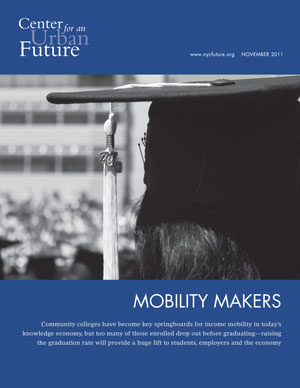Programs Show How to Increase Persistence and Help Students Graduate
It's a truism of social policy that the best anti-poverty program is a job. But in the economy of the 21st century, the best way to get and keep a job is to have a two- or four-year college degree. The federal Bureau of Labor Statistics reports that unemployment rates fall and wages rise as educational attainment increases: as of October 2009, the aggregate jobless rate for people with a high school degree or less was 12.2 percent, compared with 6.6 percent for those with some college or higher. Similarly, average yearly earnings jump at each additional level of educational attainment: in 2008, someone with an associate's degree earned an average of more than $7,500 more than an individual with no schooling beyond high school. To put it concisely: learn now, earn later.
But while the economic value of higher education has long been known, it has proven much easier to get Americans into college than to guide them to degree completion. Of students who start community college - the corner of higher education most accessible and affordable to low-income individuals - only about 35 percent earn a certificate, associate's degree or bachelor's degree within six years.
Educational researchers have devoted a great deal of attention to answering the question of why so many college students are unable to persist in higher education. Competing obligations, including family and work responsibilities, present a challenge: students who support children or other dependents often will prioritize a job over school. Another factor is how ready the student is for college-level academic work: those in need of remedial courses are statistically far less likely to earn a credential or degree. Unfortunately, almost 60 percent of community college students require at least one such course. The absence of strong personal connections - with instructors, advisors or fellow students - is regarded as yet another reason why students leave school before completion.
Last summer, the Obama administration pledged to invest $12 billion toward the American Graduation Initiative, a plan to help five million additional students graduate from community colleges by 2020. Researchers Davis Jenkins and Thomas Bailey of Columbia University's Teachers College calculate that to meet that goal, community colleges will have to boost their graduation rates by 33 percent each year through 2020. Without improving student persistence, this will not be possible.
Fortunately, a number of promising initiatives are underway to do just that. New York City's Center for Economic Opportunity, an antipoverty initiative supported with a blend of public and private funds, has backed a pilot program called Accelerated Study in Associate Programs (ASAP). The program, a partnership with the City University of New York (CUNY), operates at all six of CUNY's community college campuses. Its goal is to help 50 percent of participating students earn an associate's degree within three years�an ambitious target considering that the six-year graduation rate among the fall 2002 cohort of first-time, full-time freshmen at the same six campuses was just 26 percent.
But it seems to be working. A recent preliminary assessment of ASAP found that of the original 2007 cohort of 1,132 students, 341 - 30.2 percent - had earned an associate's degree by August 2009, a rate two and a half times higher than that for a comparison group of students that entered the same year. Another 325 students from the 2007 cohort are projected to graduate by September 2010, which would yield a three-year graduation rate of almost 60 percent, well above the target. Again, this is about two and a half times the graduation rate of CUNY community college students who entered in Fall 2006 and met the same criteria as ASAP participants, including commitment to full-time study and baseline proficiency in reading, writing and math; they had a three-year rate of 24 percent.
ASAP offers participants a set of services and incentives that researchers have highlighted as beneficial to improving student retention and graduation, including tuition waivers for financial aid-eligible students and free transportation and textbooks for all participants. The program is also structured to maximize the odds of student success by offering a consolidated schedule of classes, cohort grouping by student majors, small class sizes, and comprehensive advisement, academic and career guidance services provided by full-time ASAP staff. ASAP students who were obligated to work received assistance finding a job placement that helped them to take a full complement of classes.
ASAP provides a more comprehensive (and expensive) intervention than many community college systems can easily afford. But even embracing pieces of this approach can prove helpful to boosting persistence and completion rates. As the 2009 report of the Community College Survey of Student Engagement details, a growing number of community colleges are requiring students to engage in intensive or sustained orientation activities, which have demonstrated value in this area; schools also are using technology, including social networking tools, in innovative and helpful ways.
The battle to improve community college persistence and graduation must be waged well beyond the college campus itself. Jenkins and Bailey urge a focus at the high school level, where sophomore and junior students who take college placement exams gain a better sense - often in the form of a wake-up call - of where their skills are and where they will need to be if they are to earn a college degree. They also call for expanding "�dual enrollment",� in which high school students can earn college credits. Achieving the Dream, a national initiative of educational and philanthropic stakeholders that conducts advocacy and research to help community college students succeed, is a useful clearinghouse for other strategies to support persistence and completion.
Solving the riddle of persistence in higher education should be a top priority for public officials looking to simultaneously make a dent in poverty and ensure that the country has an ample supply of adequately skilled workers. Skills2Compete, a nonpartisan coalition of labor, business and education stakeholders that calls for every American to have at least two years of post-secondary education, estimates that the country will add millions of "�middle-skill - jobs"� - positions that require education and training beyond high school, but not a four-year college degree - in the years to come. These are career-track jobs that pay family-supporting wages: electricians and plumbers, registered nurses and medical technicians, air traffic controllers and fire fighters. Many are in relatively recession-proof sectors such as health care and technical servicing, providing security through bad times as well as good.
Just as manufacturing jobs once provided a pathway out of poverty for countless low-income families, so too could today's middle-skill jobs carry millions of impoverished Americans into the middle class. Clearly, that road runs through the community college classroom. We must do all that we can to widen and smooth it.��




